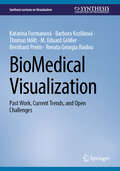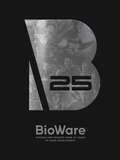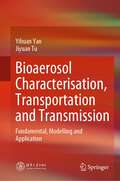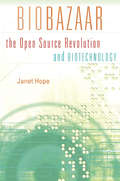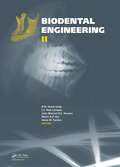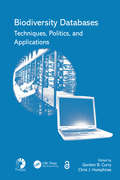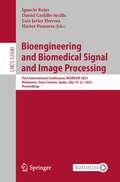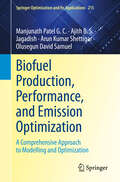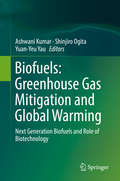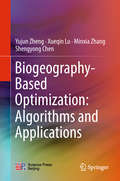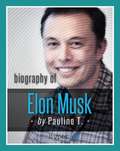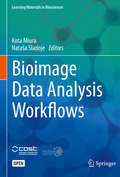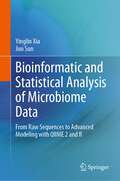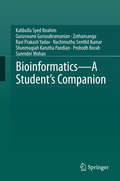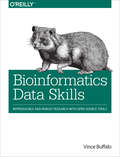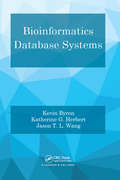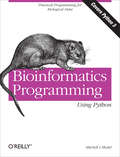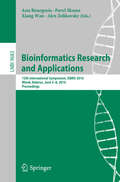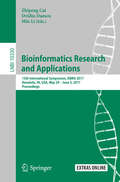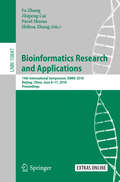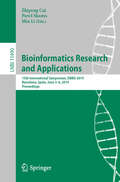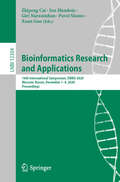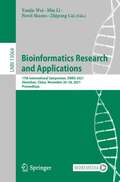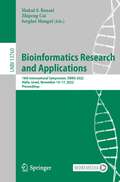- Table View
- List View
BioMedical Visualization: Past Work, Current Trends, and Open Challenges (Synthesis Lectures on Visualization)
by Bernhard Preim Katarína Furmanová Barbora Kozlíková Thomas Höllt M. Eduard Gröller Renata Georgia RaidouThis book provides an overview of the many visualization strategies that have been proposed in recent decades for solving problems within the disciplines of medicine and biology. It also evaluates which visualization techniques applied to various areas of biomedicine have been the most impactful and which challenges can be considered solved using visualization. The topics covered in this book include visualization research in omics, interaction networks and pathways, biological structures, tumor diagnosis and treatment, vasculature, brain, surgery, educational contexts, therapy and rehabilitation, electronic health records, and public health. One chapter is dedicated to general visualization techniques commonly used for biomedical data, such as surface and volume rendering, as well as abstract and illustrative approaches. For each of these areas, the past and present research trends are discussed, highlighting the influential works. Furthermore, the book explains how research is affected by developments in technology, data availability, and domain practice. Individual sections also summarize the typical target users, the nature of the data, and the typical tasks addressed in the given domain. With a uniquely broad scope, the book identifies research trends in biomedical visualization using a manually curated and searchable repository of more than 3,800 publications. The resultant trends are further categorized according to the application field and using natural language processing. The book also utilizes 16 interviews conducted with researchers in the field of biomedical visualization for the purpose of soliciting their opinions regarding the evolution and trends in the domain. The book handles these topics in a concise manner to help readers orient themselves in the already mature and diverse field of biomedical visualization without overwhelming them with technical details. As such, the book can help young researchers to become familiar with past challenges and identify future ones. For more senior researchers, it can serve as an insightful overview of the research field and the direction in which it is heading.
BioWare: Stories and Secrets from 25 Years of Game Development
by BiowareFrom the BioWare's isometric role-playing roots to its intense space operas and living worlds, chart the legendary game studio's first 25 years in this massive retrospective.BioWare - Stories and Secrets from 25 Years of Game Development puts you in the room during key moments in BioWare's history, with never-before-seen art and photos anchored by candid stories from developers past and present. See what it took to make games in those wild early days. Pore over details of secret, cancelled projects. Discover the genesis of beloved characters and games. Presented and designed by Dark Horse Books, this tribute to BioWare's legacy is a must-have for any fan of the best stories you can play.
Bioaerosol Characterisation, Transportation and Transmission: Fundamental, Modelling and Application
by Jiyuan Tu Yihuan YanThis book aims to predict and model the transport of bioaerosols, identify their transmission characteristics, and assess occupants’ infection risks. Although existing epidemiological books provide fundamental infection rate of existing diseases, the ability of predicting emerging disease transmission in the air and assessing occupants’ infection risks to the bioaerosols is significantly lacking. This book is considered as a professional book that provides in-depth discussion of the aforementioned issues and provides potential approaches to solve these issues would be highly demanded by readers in this emerging research field. This book offers essential and systematic analysis on the fate of bioaerosols from their release in the air to the final destination in human’s respiratory systems through direct 3D visualizations techniques. It also provides quantifiable method to assess each occupant’s infection risks to the infectious bioaerosols in indoor environments. The readers will gain essential fundamental characteristics of bioaerosols (active time, viability, etc.) and will gain the advanced skills on how to integrate these properties into numerical modeling and assess the occupants’ exposure risks.
Biobazaar: The Open Source Revolution and Biotechnology
by Janet HopeFighting disease, combating hunger, preserving the balance of life on Earth: the future of biotechnological innovation may well be the future of our planet itself. And yet the vexed state of intellectual property law—a proliferation of ever more complex rights governing research and development—is complicating this future. At a similar point in the development of information technology, “open source” software revolutionized the field, simultaneously encouraging innovation and transforming markets. The question that Janet Hope explores in Biobazaar is: can the open source approach do for biotechnology what it has done for information technology? Her book is the first sustained and systematic inquiry into the application of open source principles to the life sciences. The appeal of the open source approach—famously likened to a “bazaar,” in contrast to the more traditional “cathedral” style of technology development—lies in its safeguarding of community access to proprietary tools without discouraging valuable commercial participation. Traversing disciplinary boundaries, Hope presents a careful analysis of intellectual property-related challenges confronting the biotechnology industry and then paints a detailed picture of “open source biotechnology” as a possible solution. With insights drawn from interviews with Nobel Prize–winning scientists and leaders of the free and open source software movement—as well as company executives, international policymakers, licensing experts, and industry analysts—her book suggests that open source biotechnology is both desirable and broadly feasible—and, in many ways, merely awaiting its moment.
Biodental Engineering II
by João Manuel R.S. Tavares R.M. Natal Jorge J.C. Reis Campos Mário A.P. Vaz Sónia M. SantosDentistry is a branch of medicine with its own peculiarities and very diverse areas of action, which means that it can be considered as an interdisciplinary field. BIODENTAL ENGINEERING II contains the full papers presented at the 2nd International Conference on Biodental Engineering (BioDENTAL 2012, Porto, Portugal, 7-8 December 2012). The contrib
Biodiversity Databases: Techniques, Politics, and Applications
by Gordon B. CurryWith changes in technology and a renewed effort to catalog the world's biodiversity, huge amounts of data are being generated on biodiversity issues. As response to the call for better information systems to manage the biodiversity crisis, a wide range of solutions are being developed for inventorying, managing, and disseminating taxonomic data. This book brings together a diverse array of authors, expertise, and assessors that discuss technical developments to improve the construction, population, and dissemination of biodiversity information. It is designed to inform students and researchers of biodiversity about the changes and challenges that need to be understood by everyone in this information age.
Bioengineering and Biomedical Signal and Image Processing: First International Conference, BIOMESIP 2021, Meloneras, Gran Canaria, Spain, July 19-21, 2021, Proceedings (Lecture Notes in Computer Science #12940)
by Ignacio Rojas Héctor Pomares Luis Javier Herrera Daniel Castillo-SecillaThis book constitutes the refereed proceedings of the First International Conference on Bioengineering and Biomedical Signal and Image Processing, BIOMESIP 2021, held in Meloneras, Gran Canaria, Spain, in July 2021. The 41 full and 5 short papers were carefully reviewed and selected from 121 submissions. The papers are grouped in topical issues on biomedical applications in molecular, structural, and functional imaging; biomedical computing; biomedical signal measurement, acquisition and processing; computerized medical imaging and graphics; disease control and diagnosis; neuroimaging; pattern recognition and machine learning for biosignal data; personalized medicine; and COVID-19.
Biofuel Production, Performance, and Emission Optimization: A Comprehensive Approach to Modelling and Optimization (Springer Optimization and Its Applications #215)
by Jagadish Manjunath Patel G. C. Ajith B. S. Arun Kumar Shettigar Olusegun David SamuelThis book explores the urgent quest for sustainable energy solutions by examining potential renewable energy sources that meet global demands. As fossil fuels deplete at an alarming rate, this book addresses the critical challenges in selecting sustainable feedstocks and optimizing processes for industrial-scale biodiesel production. With a focus on Garcinia-gummi-gutta seeds as a promising feedstock, the book provides a detailed analysis of oil extraction, biofuel conversion, and the practical application of biodiesel in diesel engines. Key concepts explored include selecting and optimizing transesterification variables, engine performance, and emission characteristics. The authors employ cutting-edge tools such as statistical design of experiments and artificial intelligence to offer insights into biodiesel production's physics, kinetics, and mechanics. Readers will discover experimental results, intelligent modeling techniques, and optimization strategies that enhance biodiesel yield and engine efficiency while minimizing emissions. This resource is designed for engineers and researchers in renewable energy and biofuel production. It offers a systematic framework from feedstock selection to engine optimization, making it invaluable for those seeking to advance their knowledge in sustainable energy solutions. Whether you're a novice or a seasoned professional, this book provides the tools and insights needed to drive innovation in biodiesel production at an industrial scale.
Biofuels: Greenhouse Gas Mitigation and Global Warming
by Ashwani Kumar Shinjiro Ogita Yuan-Yeu YauThis timely book is a compilation of edited articles by distinguished international scientists discussing global warming, its causes as well as present and future solutions. Social and economic growth at global level is measured in terms of GDP, which requires energy inputs generally based on fossil fuel resources. These, however, are major contributors to increasing levels of CO2, causing 15 tonnes of green house gas emissions per capita. Renewable sources of energy offer an alternative to fossil fuels, and would help reduce this to the 2 tonnes of greenhouse gas emissions per capita per annum needed to achieve sustainable growth. As such, the book discusses the next-generation of biofuels and all related aspects, based on the editors’ significant investigations on biofuels over the last 30 years. It also presents the latest research findings from research work carried out by contemporary researchers. Presenting global biofuel perspectives, it examines various issues related to sustainable development of biofuels in the contexts of agriculture, forestry, industry and economic growth. It covers the 1st to 4th generation biofuels, as well as the status of biofuel resources and their potential in carbon neutral economy. Offering a comprehensive, state-of-art overview of current and future biofuels at local and global levels, this book appeals to administrators, policy makers, universities and research institutions.
Biogeography-Based Optimization: Algorithms and Applications
by Yujun Zheng Xueqin Lu Minxia Zhang Shengyong ChenThis book introduces readers to the background, general framework, main operators, and other basic characteristics of biogeography-based optimization (BBO), which is an emerging branch of bio-inspired computation. In particular, the book presents the authors’ recent work on improved variants of BBO, hybridization of BBO with other algorithms, and the application of BBO to a variety of domains including transportation, image processing, and neural network learning. The content will help to advance research into and application of not only BBO but also the whole field of bio-inspired computation. The algorithms and applications are organized in a step-by-step manner and clearly described with the help of pseudo-codes and flowcharts. The readers will learn not only the basic concepts of BBO but also how to apply and adapt the algorithms to the engineering optimization problems they actually encounter.
Biografía De Elon Musk
by Miriam Rodríguez Rodrigo Pauline T. And HyperinkTienes en tus manos una biografía amena y fácil de leer sobre una de las personas más importantes hoy en día en el mundo empresarial: Elon Musk, cofundador de empresas como PayPal, SpaceX o Tesla Motors.
Bioimage Data Analysis Workflows (Learning Materials in Biosciences)
by Kota Miura Nataša SladojeThis Open Access textbook provides students and researchers in the life sciences with essential practical information on how to quantitatively analyze data images. It refrains from focusing on theory, and instead uses practical examples and step-by step protocols to familiarize readers with the most commonly used image processing and analysis platforms such as ImageJ, MatLab and Python. Besides gaining knowhow on algorithm usage, readers will learn how to create an analysis pipeline by scripting language; these skills are important in order to document reproducible image analysis workflows. The textbook is chiefly intended for advanced undergraduates in the life sciences and biomedicine without a theoretical background in data analysis, as well as for postdocs, staff scientists and faculty members who need to perform regular quantitative analyses of microscopy images.
Bioinformatic and Statistical Analysis of Microbiome Data: From Raw Sequences to Advanced Modeling with QIIME 2 and R
by Jun Sun Yinglin XiaThis unique book addresses the bioinformatic and statistical modelling and also the analysis of microbiome data using cutting-edge QIIME 2 and R software. It covers core analysis topics in both bioinformatics and statistics, which provides a complete workflow for microbiome data analysis: from raw sequencing reads to community analysis and statistical hypothesis testing. It includes real-world data from the authors’ research and from the public domain, and discusses the implementation of QIIME 2 and R for data analysis step-by-step. The data as well as QIIME 2 and R computer programs are publicly available, allowing readers to replicate the model development and data analysis presented in each chapter so that these new methods can be readily applied in their own research. Bioinformatic and Statistical Analysis of Microbiome Data is an ideal book for advanced graduate students and researchers in the clinical, biomedical, agricultural, and environmental fields, as well as those studying bioinformatics, statistics, and big data analysis.
Bioinformatics - A Student's Companion
by Kalibulla Syed Ibrahim Guruswami Gurusubramanian Zothansanga Ravi Prakash Yadav Nachimuthu Senthil Kumar Shunmugiah Karutha Pandian Probodh Borah Surender MohanThis manual offers a stand-alone reading companion, unique in simplifying the practical components of Bioinformatics in a unique and user-friendly manner. It covers the practical component of syllabi used at most leading universities and discusses the most extensively used tools and methodologies in Bioinformatics. Research in the biological sciences has made tremendous strides in recent years due in part to the increased automation in data generation. At the same time, storing, managing and interpreting huge volumes of data has become one of the most challenging tasks for scientists. These two aspects have ultimately necessitated the application of computers, giving rise to a highly interdisciplinary discipline-Bioinformatics. Despite the richness of bioinformatics resources and methods, the exposure of life sciences undergraduates and postgraduates to bioinformatics is extremely limited. Though the internet offers various tools for free, and provides guides for using them, it fails to help users interpret the processed data. Moreover, most sites fail to update their help pages to accommodate software upgrades. Though the market is flooded with books discussing the theoretical concepts in Bioinformatics, a manual of this kind is rarely found. The content developed to meet the needs of readers from diverse background and to incorporate the syllabi of undergraduate and postgraduate courses at various universities.
Bioinformatics Data Skills
by Vince BuffaloLearn the data skills necessary for turning large sequencing datasets into reproducible and robust biological findings. With this practical guide, you'll learn how to use freely available open source tools to extract meaning from large complex biological data sets.At no other point in human history has our ability to understand life's complexities been so dependent on our skills to work with and analyze data. This intermediate-level book teaches the general computational and data skills you need to analyze biological data. If you have experience with a scripting language like Python, you're ready to get started.Go from handling small problems with messy scripts to tackling large problems with clever methods and toolsProcess bioinformatics data with powerful Unix pipelines and data toolsLearn how to use exploratory data analysis techniques in the R languageUse efficient methods to work with genomic range data and range operationsWork with common genomics data file formats like FASTA, FASTQ, SAM, and BAMManage your bioinformatics project with the Git version control systemTackle tedious data processing tasks with with Bash scripts and Makefiles
Bioinformatics Data Skills: Reproducible and Robust Research with Open Source Tools
by Vince BuffaloLearn the data skills necessary for turning large sequencing datasets into reproducible and robust biological findings. With this practical guide, youâ??ll learn how to use freely available open source tools to extract meaning from large complex biological data sets.At no other point in human history has our ability to understand lifeâ??s complexities been so dependent on our skills to work with and analyze data. This intermediate-level book teaches the general computational and data skills you need to analyze biological data. If you have experience with a scripting language like Python, youâ??re ready to get started.Go from handling small problems with messy scripts to tackling large problems with clever methods and toolsProcess bioinformatics data with powerful Unix pipelines and data toolsLearn how to use exploratory data analysis techniques in the R languageUse efficient methods to work with genomic range data and range operationsWork with common genomics data file formats like FASTA, FASTQ, SAM, and BAMManage your bioinformatics project with the Git version control systemTackle tedious data processing tasks with with Bash scripts and Makefiles
Bioinformatics Database Systems
by Jason T. Wang Kevin Byron Katherine G. HerbertModern biological databases comprise not only data, but also sophisticated query facilities and bioinformatics data analysis tools. This book provides an exploration through the world of Bioinformatics Database Systems. The book summarizes the popular and innovative bioinformatics repositories currently available, including popular primary genetic and protein sequence databases, phylogenetic databases, structure and pathway databases, microarray databases and boutique databases. It also explores the data quality and information integration issues currently involved with managing bioinformatics databases, including data quality issues that have been observed, and efforts in the data cleaning field. Biological data integration issues are also covered in-depth, and the book demonstrates how data integration can create new repositories to address the needs of the biological communities. It also presents typical data integration architectures employed in current bioinformatics databases. The latter part of the book covers biological data mining and biological data processing approaches using cloud-based technologies. General data mining approaches are discussed, as well as specific data mining methodologies that have been successfully deployed in biological data mining applications. Two biological data mining case studies are also included to illustrate how data, query, and analysis methods are integrated into user-friendly systems. Aimed at researchers and developers of bioinformatics database systems, the book is also useful as a supplementary textbook for a one-semester upper-level undergraduate course, or an introductory graduate bioinformatics course.
Bioinformatics Programming Using Python: Practical Programming for Biological Data (Animal Guide)
by Mitchell L ModelPowerful, flexible, and easy to use, Python is an ideal language for building software tools and applications for life science research and development. This unique book shows you how to program with Python, using code examples taken directly from bioinformatics. In a short time, you'll be using sophisticated techniques and Python modules that are particularly effective for bioinformatics programming.Bioinformatics Programming Using Python is perfect for anyone involved with bioinformatics -- researchers, support staff, students, and software developers interested in writing bioinformatics applications. You'll find it useful whether you already use Python, write code in another language, or have no programming experience at all. It's an excellent self-instruction tool, as well as a handy reference when facing the challenges of real-life programming tasks.Become familiar with Python's fundamentals, including ways to develop simple applicationsLearn how to use Python modules for pattern matching, structured text processing, online data retrieval, and database accessDiscover generalized patterns that cover a large proportion of how Python code is used in bioinformaticsLearn how to apply the principles and techniques of object-oriented programmingBenefit from the "tips and traps" section in each chapter
Bioinformatics Research and Applications: 12th International Symposium, ISBRA 2016, Minsk, Belarus, June 5-8, 2016, Proceedings (Lecture Notes in Computer Science #9683)
by Anu Bourgeois Pavel Skums Xiang Wan Alex ZelikovskyThis book constitutes the proceedings of the 12th International Symposium on Bioinformatics Research and Applications, ISBRA 2016, held in Minsk, Belarus, in June 2016. The 25 papers presented in this volume were carefully reviewed and selected from 77 submissions. They were organized in topical sections named: next generation sequencing data analysis; protein-protein interactions and networks; protein and RNA structure; phylogenetics; sequence analysis; and statistical methods.
Bioinformatics Research and Applications: 13th International Symposium, ISBRA 2017, Honolulu, HI, USA, May 29 – June 2, 2017, Proceedings (Lecture Notes in Computer Science #10330)
by Zhipeng Cai, Ovidiu Daescu and Min LiThis book constitutes the proceedings of the 13th International Symposium on Bioinformatics Research and Applications, ISBRA 2017, held in Honolulu, HI, USA, in May/June 2017. The 27 full papers presented together with 18 short papers and 24 invited abstracts were carefully reviewed and selected from 131 submissions. They cover topics such as: biomarker discovery; biomedical databases and data integration; biomedical text mining and ortologies; biomolecular imaging; comparative genomics; computational genetic epidemiology; computational proteomics; data mining and visualization; gene expression analysis; genome analysis; high-performance bio-computing; metagenomics; molecular evolution; molecular modelling and simulation; next-generation sequencing data analysis; pattern discovery and classification; population genetics; software tools and applications; structural biology; and systems biology.
Bioinformatics Research and Applications: 14th International Symposium, ISBRA 2018, Beijing, China, June 8-11, 2018, Proceedings (Lecture Notes in Computer Science #10847)
by Pavel Skums Zhipeng Cai Fa Zhang Shihua ZhangThis book constitutes the proceedings of the 14th International Conference on Bioinformatics Research and Applications, ISBRA 2018, held in Beijing, China, in June 2018.The 24 full and 10 short papers presented in this volume were carefully reviewed and selected from a total of 138 submissions. They were organized in topical sections named: network analysis and modelling; genomic data analysis; cancer data analysis; structure and interaction; HPC and CryoEM; machine and deep learning; data analysis and methodology; analysis and visualization tools; and RNA-Seq data analysis.
Bioinformatics Research and Applications: 15th International Symposium, ISBRA 2019, Barcelona, Spain, June 3–6, 2019, Proceedings (Lecture Notes in Computer Science #11490)
by Min Li Pavel Skums Zhipeng CaiThis book constitutes the proceedings of the 15th International Symposium on Bioinformatics Research and Applications, ISBRA 2019, held in Barcelona, Spain, in June 2019. The 22 full papers presented in this book were carefully reviewed and selected from 95 submissions. They were organized in topical sections named: genome analysis; systems biology; computational proteomics; machine and deep learning; and data analysis and methodology.
Bioinformatics Research and Applications: 16th International Symposium, ISBRA 2020, Moscow, Russia, December 1–4, 2020, Proceedings (Lecture Notes in Computer Science #12304)
by Xuan Guo Ion Mandoiu Pavel Skums Zhipeng Cai Giri NarasimhanThis book constitutes the proceedings of the 16th International Symposium on Bioinformatics Research and Applications, ISBRA 2020, held in Moscow, Russia, in December 2020. The 23 full papers and 18 short papers presented in this book were carefully reviewed and selected from 131 submissions. They were organized in topical sections named: genome analysis; systems biology; computational proteomics; machine and deep learning; and data analysis and methodology.
Bioinformatics Research and Applications: 17th International Symposium, ISBRA 2021, Shenzhen, China, November 26–28, 2021, Proceedings (Lecture Notes in Computer Science #13064)
by Min Li Pavel Skums Zhipeng Cai Yanjie WeiThis book constitutes the proceedings of the 17th International Symposium on Bioinformatics Research and Applications, ISBRA 2021, held in Shenzhen, China, in November 2021. The 51 full papers presented in this book were carefully reviewed and selected from 135 submissions. They were organized in topical sections named: AI and disease; computational proteomics; biomedical imaging; drug screening and drug-drug interaction prediction; Biomedical data; sequencing data analysis.
Bioinformatics Research and Applications: 18th International Symposium, ISBRA 2022, Haifa, Israel, November 14–17, 2022, Proceedings (Lecture Notes in Computer Science #13760)
by Zhipeng Cai Serghei Mangul Mukul S. BansalThis book constitutes the proceedings of the 18th International Symposium on Bioinformatics Research and Applications, ISBRA 2022, held in Haifa, Israel, in November 14–17, 2022.The 30 full papers and 4 short papers presented in this book were carefully reviewed and selected from 72 submissions. They were organized in topical sections named: AI and disease; computational proteomics; biomedical imaging; drug screening and drug-drug interaction prediction; Biomedical data; sequencing data analysis.
